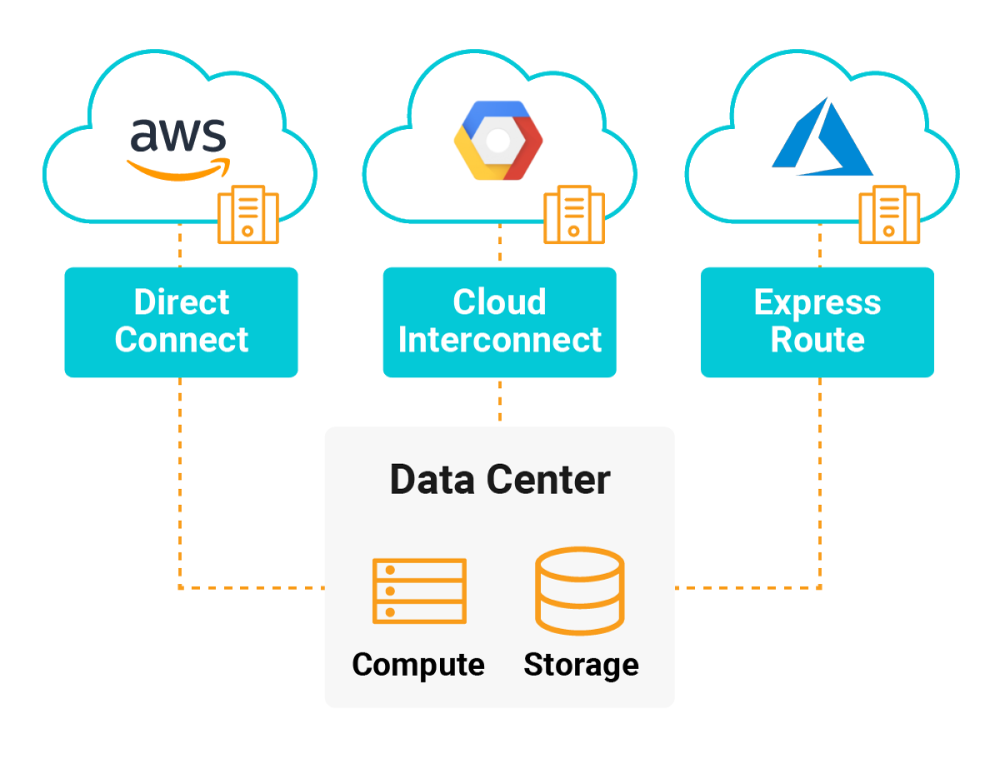In today’s world where digital transformation is the catchword, businesses are looking upon multi-cloud strategies to stay at the competitive edge. Imagine having the privilege to leverage the best cloud features from multiple providers to streamline performance and alleviate risks, all the while ensuring that data and applications are readily available. Does it sound good?
But adopting a multi-cloud approach is not as easy as signing up for some cloud service. It needs a clear-cut strategy and careful planning to exploit its full potential. Whether you are seeking to attain cost savings, improve flexibility, or reinforce resilience, executing a multi-cloud strategy can be intimidating.
However, we have broken down this process into seven simple steps to make it easy for you to conceptualize and execute it. In this blog, we shall explain the concept of multi-cloud architecture in detail and bring out its key benefits. We will also walk you through each step of multi-cloud implementation, thus enabling you to create a framework that is effective as well as efficient. Are you ready to get started? Here you go!
What is a multi-cloud framework?
A multi-cloud refers to a cloud computing architecture that includes multiple services from leading cloud service providers such as Google Cloud Platform, Amazon Web Services, Microsoft Azure, etc., available in the same IT framework.
A simple multi-cloud environment may include a certain company using two separate cloud providers to obtain a service such as Software-as-a-Service (SaaS). However, in a much more complicated scenario, a multi-cloud model is far beyond a simple SaaS delivery. For instance, an enterprise may use Google Cloud for disaster recovery and backup, AWS for development as well as testing new apps, and Microsoft Azure for data storage. Apart from SaaS, many organizations rely upon service providers for services including Platform-as-a-Service (PaaS) and Infrastructure-as-a-Service (IaaS).
A multi-cloud arrangement integrating three cloud services

A multi-cloud structure can greatly benefit businesses seeking to sectionalize their workloads with cloud service providers that may provide cost-effective options for certain tasks such as database management or data analytics. Businesses can build a personalized ecosystem tailor-made for their requirements – technical or business-specific. This approach offers greater scalability, resilience, and flexibility by allocating workloads across different cloud environments.
A 2023 study indicates that multi-cloud adoption is increasingly becoming the norm in the enterprise technology domain. According to the survey, around 98% of the enterprises already use or plan to use the services of at least two cloud service providers, with a staggering 31% relying upon more than four providers. This highlights the importance of the multi-cloud approach in the modern world.
The Hybrid Multi-Cloud Landscape
Nowadays, a multi-cloud architecture is normally conjoined with hybrid cloud, which is a cloud computing model that combines on-premise, private cloud, and public cloud infrastructures. A hybrid cloud architecture builds a single and flexible IT framework that facilitates the portability and interoperability of workloads throughout multiple cloud environments. When united, the multi-cloud and hybrid models offer a hybrid-multi-cloud structure that provides businesses the opportunity to have the best of both worlds for building, migrating, and optimizing apps all through multiple clouds.
Does your organization really require a multi-cloud environment?
Embracing a multi-cloud strategy empowers you to manage applications directly, giving you complete control over crucial elements such as uptime, downtime, latency, and cost, which has a significant impact on the customer experience. This approach helps you to deal with vendor lock-in, thus enabling you to locate the cloud services and products that provide value.
Your enterprise may benefit from a multi-cloud approach if you focus on:
- Ensuring greater availability to avoid website downtime.
- Improving flexibility and avoiding vendor lock-in.
- Assuring optimum latency as well as load times for the customers.
- Ensuring vigorous data protection and risk alleviation planning.
- Assuring continual access for enhancing network performance.
- Ensuring availability of competitive pricing among cloud service providers.
- Assuring adherence to region-wise compliance regulations.
These preferences require a broader set of options and features, which a single cloud service provider many find difficult to fulfill.
Steps for creating an effective multi-cloud strategy
The administrative and technical complications are bound to increase when you deal with multiple cloud environments and vendors. While every multi-cloud journey is distinct, here are seven fundamental steps for building an effective multi-cloud strategy:
- Defining goals
A multi-cloud journey starts with positioning business goals with a general strategic plan. Begin by evaluating your company’s existing applications and infrastructure. Identify the workload requirements as well as objectives concerning the use cases.
A hybrid multi-cloud environment supports integrated data transfer across all multi-cloud environments, thereby assuring zero downtime, low latency, and effortless data delivery. For example, a healthcare company may look for a multi-cloud environment to enable data sharing in real-time across different geographical locations to ensure optimum patient care.
- Choosing the best-in-class cloud service providers (CSPs)
While most of the CSPs provide basic functionalities, they also offer some distinct services and features. Whether it is advanced analytics of a certain provider or a high-performance computing feature of another, a multi-cloud model helps you chose the best-in-class cloud services to meet your requirements. Also, carefully review the service contracts as many CSPs offer low starting costs and flexible contracts.
- Creating a single pane of glass
In a multi-cloud setting, Application Programming Interfaces (APIs) from different cloud environments may cause visibility challenges. To exploit the complete benefits of a multi-cloud framework, a central platform or console is required to build a single pane of glass for a consolidated visibility of the enterprise. Generally referred to as a CMP or a cloud management platform, this dynamical and secure solution enables IT teams to create, monitor, govern, and manage their multi-cloud infrastructures.
- Leveraging automation tools
The automation of IT processes and existing infrastructure plays an important role in a multi-cloud framework. Using automation tools, enterprises can minimize manual tasks allotted to IT personnel. Cloud automation builds a software layer that operates on virtual machines in private or public cloud environments.
Further, you can minimize the utilization of computing resources and save on the cloud spend by carefully reviewing the automation tools required for your organization’s CMP. Some multi-cloud automation solutions such as Infrastructure as Code (IaC) help to simplify the infrastructure management process, while at the same time enhancing consistency and minimizing the manual configuration requirements.
- Building a zero-trust security strategy
Managing a multi-cloud approach implies having a zero-trust security model in place. This model works on the assumption that the security of a complex network is at risk due to internal and external threats. Further, this approach demands numerous security capabilities including policies to control access across privileged accounts and users by employing single sign-on (SSO) and multifactor authentication. Most of the leading CSPs provide security solutions for multi-cloud model to manage threats effectively and assure resiliency.
- Incorporating regulatory and compliance requirements
Enterprise-level corporations with global presence need to comply with several regulatory standards prevalent in different jurisdictions and countries. Further, adhering to industry standards is critical for companies in energy, healthcare, finance and several others.
Non-compliance to industry regulations can put confidential data at risk, leading to financial and legal consequences as well as reputational damage. Businesses can alleviate risks and reinforce trust with clients by incorporating compliance rules during the development and deployment phases of multi-cloud models.
- Adopting FinOps for cost optimization
A multi-cloud cost management plan incorporates the best practices and techniques to control and manage costs. FinOps enables organizations to enhance their business value in a hybrid multi-cloud environment. Furthermore, combining AI-enabled cost-management solutions and FinOps can help with cloud cost optimization and improvements in application performance.
Advantages of adopting a multi-cloud strategy
Here are some benefits of implementing a multi-cloud strategy which helps you distribute assets judiciously throughout the cloud-hosting environments.
- Competitive pricing
With the increase in the number of multi-cloud providers, there are competitors all around striving to provide optimum pricing for various resources. Accordingly, the businesses can compare the prices of different providers and choose the best options according to their specific requirements.
- Agility
Several traditional enterprises are still struggling with their legacy systems, hardware suppliers, and on-premise structures. They often lack the ability to manage multi-cloud operations all by themselves, and hence look for experienced providers to carry out the task. With the right expertise at their disposal, they can achieve workload mobility and agility for diverse cloud platforms.
- Flexibility and scalability
With 90% of data already created in the last two years, multi-cloud provides a suitable platform to manage and store data with real-time synchronization and automation. Multi-cloud is a great solution for scalability apart from its storage capabilities, as it enables enterprises to scale up or scale down according to their requirements.
- Sustained resilience
A multi-cloud structure can help safeguard your enterprise’s critical data and applications by providing additional backup and recovery options, thereby offering business continuity in case of emergencies caused by power outage, natural disaster, or failed disk.
Challenges of implementing a multi-cloud architecture
Although a multi-cloud framework is an essential element of the digital transformation landscape, the complexity of operating multiple clouds from different service providers offers many challenges. Here are a select few:
- Data silos: As the data is distributed across multiple platforms and clouds, an enterprise runs the risk of forming data silos, leading to visibility issues which may have a negative impact on data analytics. This prevents teams from providing a comprehensive view of the consolidated data, which is required for collaboration and decision-making.
- Cloud sprawl: This is one of the major challenges encountered while running a multi-cloud environment. Cloud sprawl refers to unrestrained growth of an enterprise’s cloud services which can cause overprovisioning (allocation of excessive computing resources to a system or an application) and unnecessary expenses.
- Uncontrolled costs: Multiple clouds translate into additional costs. Although the pay-per-usage structure can curb cloud expenditure, unexpected costs may arise due to the difficulty in monitoring various CSP pricing models.
- Security risks: Having robust security measures in place is essential for cloud adoption. A complicated multi-cloud setting with data shifting across public and private clouds causes obvious risks.
Multi-cloud implementation – Use cases
There are many practical applications for the multi-cloud model. Here are a few examples:
1.Speeding up digital transformation and delivering brand new applications
Enterprises can access a wide range of services and technologies by leveraging the capabilities of multiple clouds. Further, they can deploy applications quickly and innovate using the multi-cloud landscape. This flexibility empowers the enterprises to scale up their apps and quickly respond to customer demands and market changes.
2.Supporting distributed workforce
The increase in distributed workforce accentuates the need for accessible, secure, and flexible IT resources. A multi-cloud framework facilitates this by offering the infrastructure needed to deploy as well as manage applications in different cloud environments, thus ensuring accessibility of data and tools to employees working across different locations.
3.Implementing multi-cloud Kubernetes clusters
Emplacing multi-cloud Kubernetes clusters exemplifies the benefits of having a multi-cloud model. Kubernetes, an open-source arrangement for automating the scaling, management, and deployment of containerized apps, can operate on any cloud environment. Implanting Kubernetes clusters all through multiple cloud environments enables organizations to attain disaster recovery, flexibility, and high availability in the instance of workload deployment. This strategy enables workloads to be transferred between multiple clouds, thereby optimizing performance and costs.
Summing it up
Adopting a multi-cloud approach can greatly benefit organizations that rely on cloud for the critical components of their IT ecosystem. With new multi-cloud capabilities coming up each day, businesses need to ensure that they can access the best resources in networking, storage, security, and application deployment.
As a leading cloud service provider, Milestone offers cutting edge solutions in the hybrid multi-cloud domain. With its strong cloud expertise, Milestone ensures the best combination of cloud services for its customers to stay ahead in today’s rapidly changing digital environment.
If you have any queries regarding our cloud services, don’t hesitate to reach out to us at itsolutions@milestone.tech.




